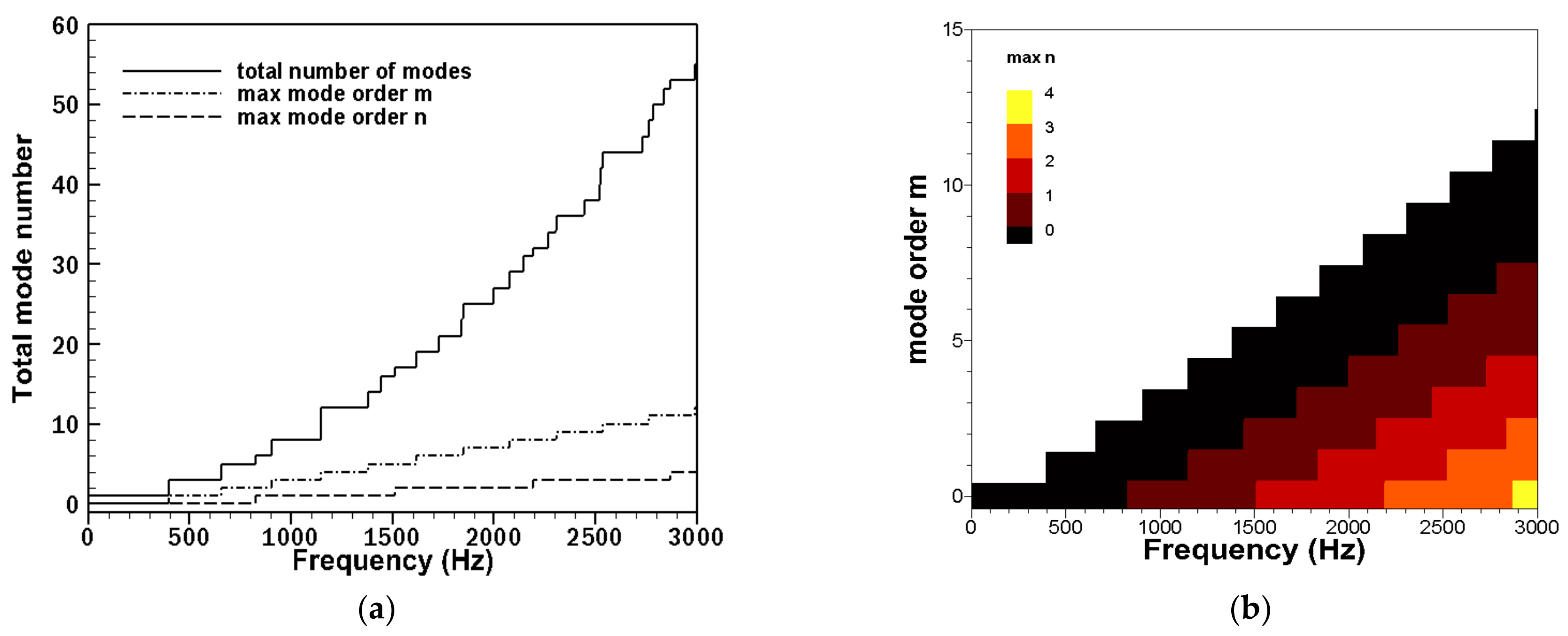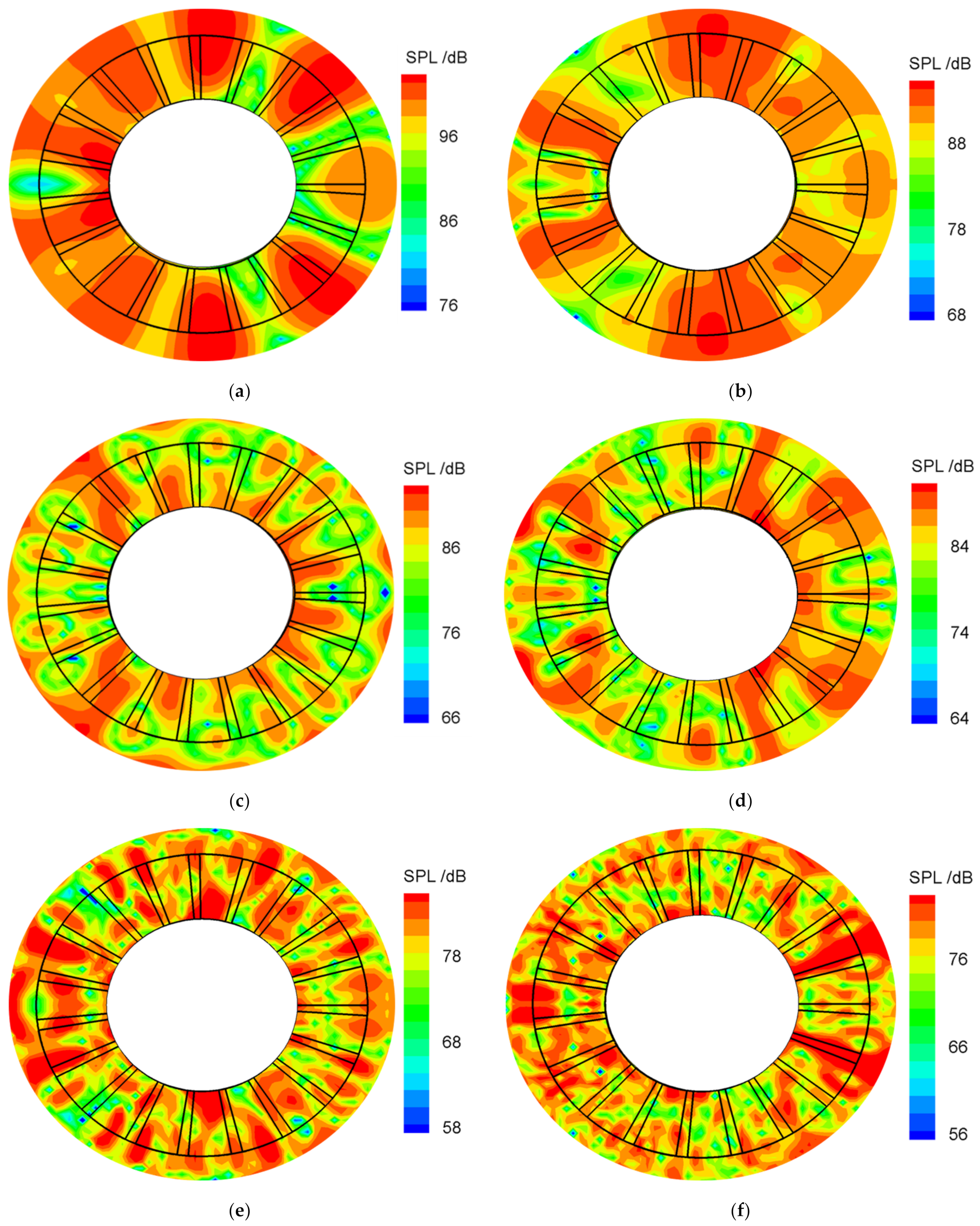The Methodological and Experimental Research on the Identification and Localization of Turbomachinery Rotating Sound Source
Abstract
:1. Introduction
2. Measurement Theory
2.1. Beamforming and Clean-SC
2.2. Virtual Rotating Array
2.3. Modal Steering Vector
3. Experimental Setup
3.1. Experimental Facility
3.2. Modal Function Spectrum
4. Results and Discussion
4.1. Simulation Application
4.2. Experimental Application
5. Conclusions
Author Contributions
Funding
Data Availability Statement
Conflicts of Interest
Abbreviations
| sound source | |
| speed of sound | |
| acoustic sound pressure | |
| density of the flow | |
| frequency of interest | |
| emission time | |
| radial shape function of the (m, n) mode | |
| R | duct radius |
| n | radial mode order |
| t | time |
| Xm(t) | acoustic information |
| point spread function | |
| Green function | |
| intensity distribution of dipole source | |
| unit vector | |
| axial wave number of (m, n) mode | |
| m | circumferential mode order |
References
- Pannert, W.; Maier, C. Rotating beamforming–motion-compensation in the frequency domain and application of high-resolution beamforming algorithms. J. Sound Vib. 2013, 333, 1899–1912. [Google Scholar] [CrossRef]
- Herolda, G.; Sarradj, E. Microphone array method for the characterization of rotating sound sources in axial fans. Noise Control Eng. 2015, 63, 546–551. [Google Scholar] [CrossRef]
- Sijtsma, P. Feasibility of In-duct Beamforming. In Proceedings of the 13th AIAA/CEAS Aeroacoustics Conference, AIAA 2007-3696, Rome, Italy, 21–23 May 2022. [Google Scholar]
- Sijtsma, P. Using Phased Array Beamforming to Locate Broadband Noise Sources Inside a Turbofan Engine; NLR Report, NLR-TP-2009-689; National Aerospace Laboratory NLR: Amsterdam, The Netherlands, 2010. [Google Scholar]
- Sijtsma, P.; Oerlemans, S.; Holthusen, H. Location of Rotating Sources by Phased Array Measurements; NLR Report, NLR-TP-2001-135; National Aerospace Laboratory NLR: Amsterdam, The Netherlands, 2001. [Google Scholar]
- Minck, O.; Binder, N.; Cherrier, O.; Lamotte, L.; Pommier-Budinger, V. Fan noise analysis using a microphone array. In Proceedings of the Fan 2012-International Conference on Fan Noise, Technology, and Numerical Methods, FR, Senlis, France, 18–20 April 2012; pp. 1–9. [Google Scholar]
- Holland, K.R.; Nelson, P.A. An experimental comparison of the focused beamformer and the inverse method for the characterisation of acoustic sources in ideal and non-ideal acoustic environments. J. Sound Vib. 2012, 331, 4425–4437. [Google Scholar] [CrossRef]
- Brooks, T.F.; Humphreys, W.M., Jr. Deconvolution Approach for the Mapping of Acoustic Sources (DAMAS) determined from phased microphone arrays. In Proceedings of the 10th AIAA/CEAS Aeroacoustics Conference, Manchester, UK, 10–12 May 2004. [Google Scholar]
- Sijtsma, P. CLEAN Based on Spatial Source Coherence; NLR Report, NLR-TP-2007-345; National Aerospace Laboratory NLR: Amsterdam, The Netherlands, 2007. [Google Scholar]
- Sarradj, E. A fast signal subspace approach for the determination of absolute levels from phased microphone array measurements. J. Sound Vib. 2019, 329, 1553–1569. [Google Scholar] [CrossRef]
- Dougherty, R.P.; Ramachandran, R.C.; Raman, G. Deconvolution of sources in aeroacoustic images from phased microphone arrays using linear programming. Int. J. Aeroacoustics 2013, 12, 699–717. [Google Scholar] [CrossRef]
- Underbrink, J.R.; Dougherty, R.P. Array design for non-intrusive measurement of noise sources. Proc. Noise-Con 1996, 96, 10019651198. [Google Scholar]
- Dougherty, R.; Walker, B. Virtual rotating microphone imaging of broadband fan noise. In Proceedings of the 15th AIAA/CEAS Aeroacoustics Conference, AIAA 2009-3121, Miami, FL, USA, 11–13 May 2009. [Google Scholar]
- Lowis, C.R.; Joseph, P. A focused beamformer technique for separating rotor and stator-based broadband sources. In Proceedings of the 12th AIAA/CEAS Aeroacoustics Conference, AIAA-2006-2710, Cambridge, MA, USA, 8–10 May 2006. [Google Scholar]
- Lowis, C.R. In-Duct Measurement Techniques for the Characterisation of Broadband Aeroengine Noise. Ph.D. Thesis, University of Southampton, Southampton, UK, 2007. [Google Scholar]
- Poletti, M.A.; Teal, P.D. Comparison of methods for calculating the sound field due to a rotating monopole. J. Acoust. Soc. Am. 2011, 129, 3513–3520. [Google Scholar] [CrossRef] [PubMed]
- Poletti, M.A. Series expansion of rotating two and three dimensional sound fields. J. Acoust. Soc. Am. 2010, 128, 3513–3520. [Google Scholar] [CrossRef] [PubMed]
- Carley, M. Series expansion for the sound field of rotating sources. J. Acoust. Soc. Am. 2006, 120, 1252–1256. [Google Scholar] [CrossRef] [Green Version]
- Carley, M. Inversion of spinning sound fields. J. Acoust. Soc. Am. 2009, 125, 690–697. [Google Scholar] [CrossRef] [PubMed] [Green Version]
- Carley, M. Sound radiation from propellers in forward flight. J. Sound Vib. 1999, 225, 353–374. [Google Scholar] [CrossRef]
- Finez, A.; Leneveu, R.; Picard, C.; Leneveu, R.; Souchotte, P. In-Duct Acoustic Source Detection Using Acoustic Imaging Techniques. In Proceedings of the 19th AIAA/CEAS Aeroacoustics Conference, Berlin, Germany, 27–29 May 2013. [Google Scholar]
- Gérard, A.; Berry, A.; Masson, P. Control of tonal noise from subsonic axial fan, Part 1. J. Sound Vib. 2015, 288, 1049–1075. [Google Scholar] [CrossRef]
- Caldas, L.C.; Greco, P.C.; Pagani, C.C.; Baccalá, L.A. Comparison of different techniques for rotating beamforming at the University of São Paulo fan rig test facility. In Proceedings of the 6th Berlin Beamforming Conference, BeBeC-2016-D14, Berlin Germany, 24–25 February 2016. [Google Scholar]
- Johnson, D.H.; Dudgeon, D.E. Array Signal Processing: Concepts and Techniques; Prentice Hall: Hoboken, NJ, USA, 1993. [Google Scholar]
- Krömer, F.; Müller, J.; Becker, S. Investigation of aeroacoustic properties of low-pressure axial fans with different blade stacking. AIAA J. 2018, 56, 1507–1518. [Google Scholar] [CrossRef]
- Zhu, T.; Lallier-Daniels, D.; Sanjosé, M.; Moreau, S.; Carolus, T. Rotating coherent flow structures as a source for narrowband tip clearance noise from axial fans. J. Sound Vib. 2018, 417, 198–215. [Google Scholar] [CrossRef]









Publisher’s Note: MDPI stays neutral with regard to jurisdictional claims in published maps and institutional affiliations. |
© 2022 by the authors. Licensee MDPI, Basel, Switzerland. This article is an open access article distributed under the terms and conditions of the Creative Commons Attribution (CC BY) license (https://creativecommons.org/licenses/by/4.0/).
Share and Cite
Xu, K.; Shi, Y.; Qiao, W.; Wang, Z. The Methodological and Experimental Research on the Identification and Localization of Turbomachinery Rotating Sound Source. Energies 2022, 15, 8647. https://doi.org/10.3390/en15228647
Xu K, Shi Y, Qiao W, Wang Z. The Methodological and Experimental Research on the Identification and Localization of Turbomachinery Rotating Sound Source. Energies. 2022; 15(22):8647. https://doi.org/10.3390/en15228647
Chicago/Turabian StyleXu, Kunbo, Yun Shi, Weiyang Qiao, and Zhirong Wang. 2022. "The Methodological and Experimental Research on the Identification and Localization of Turbomachinery Rotating Sound Source" Energies 15, no. 22: 8647. https://doi.org/10.3390/en15228647



